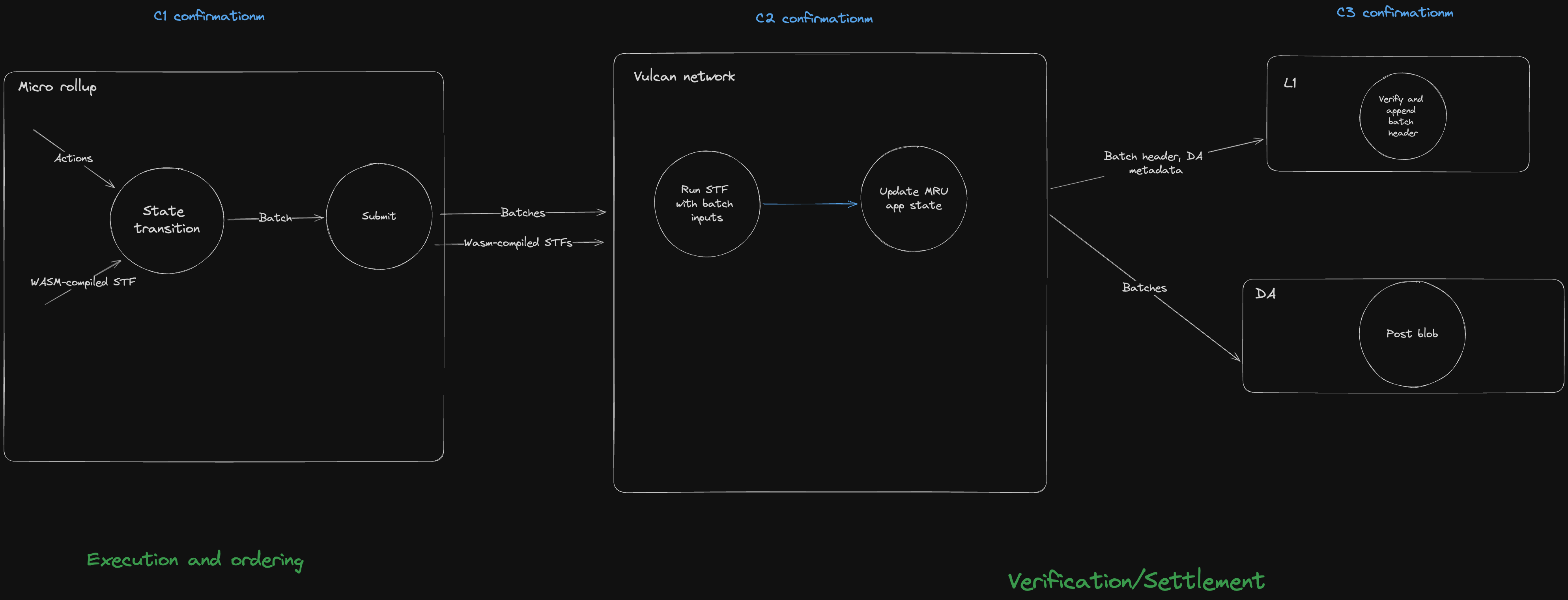Verification Layer
The Stackr verification layer, also known as "Vulcan" is responsible for
- Verification: Check correctness of state transitions
- Fast finality: Provide soft confirmations to microrollups (also known as C2 confirmation)
- Settlement: Provide data availability and hard confirmations to microrollups (also known as C3 confirmation)
- Bridging (Coming soon): Provide fast and secure message passing between microrollups
Therefore, Vulcan provides a flexible range of settlement-as-a-service options for micro-rollups and lets developers focus on their core business logic.
Verification
Deployment

Before Vulcan can start verifying blocks, the developer must first build out their Stackr State machine (SSM) and deploy it as a microrollup (execution layer).
The SSM is then compiled down to a WASM binary and sent to Vulcan, alongwith an initial genesis state. This all happens when executing the deploy CLI command.
After deployment, MRUs will be able to send blocks at a developer-set cadence to Vulcan which then verifies the state transitions in each of the blocks while ensuring consecutive block height ordering.
Now we will delve into the key features of verification:
Pessimistic re-execution with WASM

Vulcan employs a pessimistic re-execution model to verify the incoming blocks from micro-rollups. This means that Vulcan will use the application’s deployed WASM binary and apply the actions inside a block one-by-one on the current state to generate a new state. It then matches the generated state roots with the state root provided in the block. If this succeeds, the newly generated state becomes the current state for the next block to be verified.
WebAssembly (WASM) is a binary instruction format. It is designed as a portable target for high-level languages like Go, C, Python, and Rust. WASM ensures a secure and sandboxed environment to execute the application logic. It also keeps the verification layer agnostic to the language and framework used to build out a microrollup. Developers can build microrollups in any language that compiles down to WASM and it will work seamlessly with Vulcan.
zkWASM Integration

Stackr is also exploring the potential of zkWASM-based verification, enabling Vulcan to execute application WASM binaries within a zkVM and generate STARK proofs. These proofs can be aggregated into a single STARK proof and wrapped in a groth16 SNARK wrapper for final verification on the parent chain. Proof aggregation will amortize the cost of verifying multiple blocks in a single proof, leading to cheaper and more scalable verification. It will also enable highly secure settlement of blocks onchain.
Fast finality
Since the Vulcan layer is responsible for checking the correctness of actions, it can also provide a confirmation before the data hits the parent chain.
Once a block passes the verification step, Vulcan will emit a C2 confirmation event to the corresponding MRU and approve the block for settlement.
As mentioned previously, Stackr’s Micro-rollups provide multiple levels of confirmations, which can be used for building different user experiences. Vulcan behaves like a fast finality settlement layer, providing soft confirmations orders of magnitude faster than the underlying parent chain and DA layer.
Settlement
Once an incoming block is verified, Vulcan will first ensure its availability by posting it to a DA layer of the developer's choice. This can be Avail, Celestia or EigenDA.
After finalizing proof of data publication, Vulcan will emit a C3A confirmation event to denote guaranteed data availability and then proceed to submit the batch (a set of blocks) to the corresponding MRU's AppInbox smart contract on the parent chain.
On successful submission, the batch (a set of blocks) will be appended to the canonical chain on L1 and Vulcan will emit a C3B confirmation event denoting succesful settlement of the batch onchain.